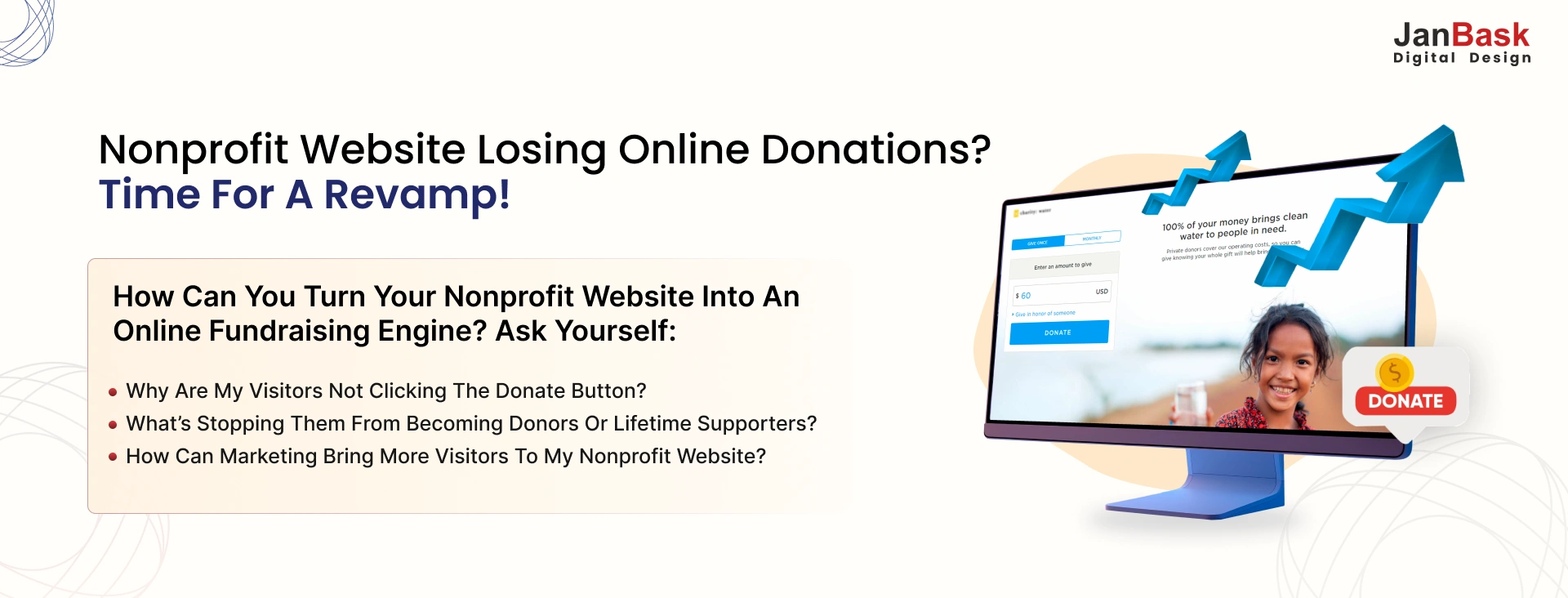
You’re changing the world, but is the world noticing?
You’ve got heart. You’ve got vision. You’re running programs, answering emails at 10 PM, juggling volunteers, and maybe even writing a grant in between meetings. You wear ten hats a day, and somewhere in there, you’re supposed to “do marketing,” too.
But here’s the truth:
Even the most impactful mission can fade into the background if it’s not seen, heard, and understood.
In a world where donors scroll fast and attention spans are shorter than a goldfish’s, nonprofit marketing isn’t a “nice to have”; it’s essential. And no, we’re not talking about randomly posting on Facebook or sending one email before Giving Tuesday. We’re talking about a strategy, one that turns your mission into momentum, your voice into visibility, and your efforts into measurable impact.
This guide is your step-by-step roadmap to get there.
No jargon. No fluff. Just 8 clear steps to build a nonprofit marketing strategy that works, even if your budget is tiny and your team is just… you.
Let’s get your story the spotlight it deserves.
Ever feel like you're doing incredible work, but no one knows about it? That’s where nonprofit marketing comes in. It’s not about selling products, it’s about sharing your mission in a way that moves people to act. You're not just asking for donations; you're inviting others to be part of something bigger. Whether it's rallying volunteers, inspiring monthly donors, or sparking awareness, marketing is how your message reaches the right hearts. The goal? To turn passion into participation, and quiet admiration into real support. Because if your story isn’t being told, how will anyone know the change you’re making?
If you’ve ever felt like your efforts are all over the place, posting on social media one day, rushing a newsletter the next, and still not seeing results, you’re not alone. Without a plan, even the most passionate teams burn out fast.
A strong marketing plan brings clarity to the chaos. It aligns your messaging with your mission, helps you prioritize what matters, and ensures every campaign, post, or outreach has a clear purpose behind it. Instead of reacting, you’re leading with intention, strategy, and confidence.
Think of it as your nonprofit’s GPS: when you have a roadmap, you don’t waste time taking wrong turns. You stay focused, reach the right audience, and move steadily toward your goals.

Ever sat through a nonprofit webinar and thought, “That sounds smart… but what does it actually mean for us?” While marketing gurus debate algorithms and funnels, you're just trying to figure out how to get more people to care about your mission.
Let’s bring it back to the basics, but the kind that actually drive results. The 5 W’s framework, Who, What, When, Where, and Why, isn’t just for grade school writing. It’s the foundation of every smart, strategic nonprofit marketing plan.
Before you post, promote, or print another flyer, answering these five questions will help you align your message, audience, and mission with total clarity. It's simple, but powerful, and it works whether you're running a national nonprofit or a local rescue center.
You're not marketing to everyone, even though your cause might benefit everyone. Successful nonprofits create detailed audience segments that go far beyond basic demographics.
Your primary audiences include current donors who already believe in your mission, potential volunteers looking for meaningful ways to contribute, and the beneficiaries who directly experience your impact. Each group has different motivations, communication preferences, and decision-making processes.
Secondary audiences often hold the keys to exponential growth. Community leaders can endorse your work to hundreds of followers. Corporate partners bring both funding and employee volunteer opportunities. Local media outlets can amplify a single story to thousands of potential supporters.
Here's where most organizations stumble. They create one generic message and blast it everywhere, hoping someone will respond. Instead, map out what drives each audience segment. What fears keep your major donors awake at night? What personal fulfillment do volunteers seek from their service?
Vague goals produce vague results. Your marketing objectives should connect directly to specific mission outcomes that matter to your organization's survival and growth.
Maybe you need 200 new monthly donors to fully fund your after-school programs. Perhaps you're targeting 50 skilled volunteers to launch your job training initiative. These concrete numbers give your team clear targets to aim for.
Your core messaging goes deeper than describing what you do. It explains why your work matters right now, in this moment, to the people you're trying to reach. The most compelling nonprofit messages tap into universal human desires: belonging, purpose, legacy, and making a difference.
Timing transforms good campaigns into exceptional ones. Your annual marketing calendar should account for when your specific audiences are most receptive to different types of messages.
December's giving surge is well-documented, but other seasonal patterns matter too. Spring brings volunteer enthusiasm as people emerge from winter hibernation. Back-to-school season energizes education-focused supporters. Environmental causes see engagement peaks around Earth Day and World Wildlife Day.
Plan your major campaigns at least six months in advance. This prevents the last-minute panic that leads to rushed, ineffective outreach. Your team can craft compelling stories, design professional materials, and coordinate partnerships when they're not racing against deadlines.
Platform selection makes or breaks your outreach efforts. Your audience research should reveal where your supporters actually spend their time, not where you think they should be.
If you're targeting retirees for your community garden project, Facebook might deliver better results than TikTok. Corporate partnerships often develop through LinkedIn networking rather than Instagram posts. Local nonprofits need different channel strategies than national organizations.
Don't forget the power of offline channels either. Community events, local newspaper coverage, and word-of-mouth referrals often outperform digital efforts for building deep, lasting relationships.
Every marketing decision should strengthen your mission, not distract from it. This principle helps you evaluate opportunities and say no to tactics that don't serve your core purpose.
When skeptical board members question marketing expenses, your mission alignment becomes your strongest defense. Show them exactly how strategic outreach multiplies your impact by reaching more people who care about your cause.
Your marketing rationale also guides resource allocation. Should you spend limited dollars on Facebook ads or community event sponsorships? The answer depends on which option better advances your specific mission among your target audiences.
You've built the foundation with your 5 W's framework. Now it's time to construct the actual marketing system that will transform your organization's reach and impact.
This isn't another theoretical model that looks good on paper but falls apart in real life. These eight steps have been tested by hundreds of nonprofits, from tiny local food banks to major international relief organizations.
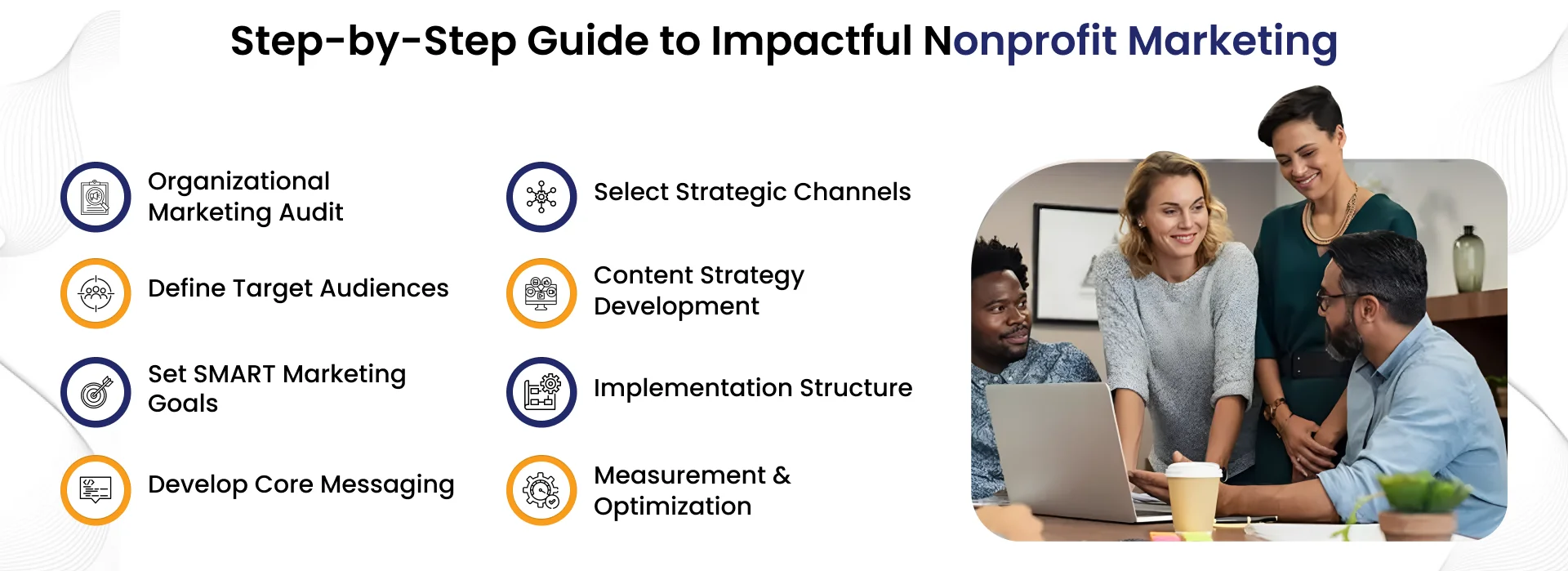
Before you can plan where you're going, you need to understand exactly where you stand right now. Your marketing audit reveals the brutal truth about your current efforts and uncovers hidden opportunities you might be missing.
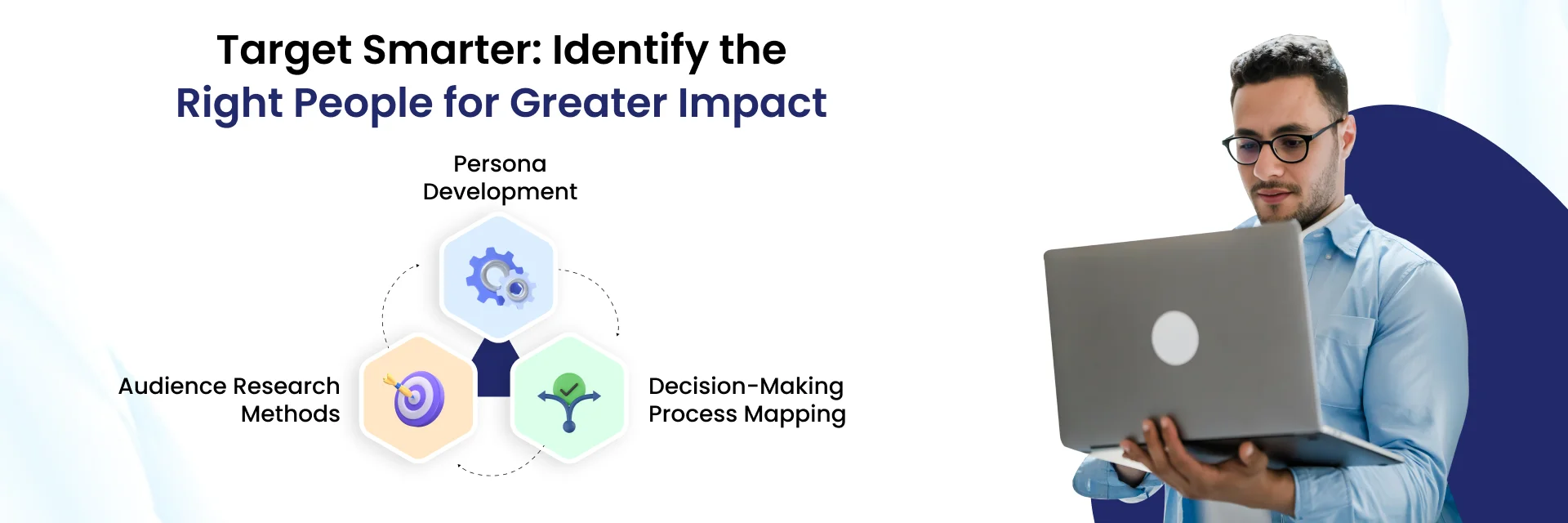
Before you plan forward, take a step back. Gather every marketing piece your nonprofit has created over the past year: emails, social posts, brochures, event flyers, website pages, everything. This isn’t just about collecting content; it’s about spotting patterns, gaps, and opportunities. Use a simple spreadsheet to track each item’s purpose, audience, and performance (if you have the data). This audit gives you a clear picture of what’s working and what’s just noise.
Now that you've gathered your content, it’s time to dig into what actually moved the needle. Which social posts sparked real donations, not just reactions? Which emails got opened, read, and clicked? Go beyond vanity metrics and focus on actions tied to your mission. This step reveals what’s worth repeating and what needs to go. Data-driven insights will shape smarter strategies moving forward.
Your SWOT analysis should dig deeper than surface-level observations. Maybe your strength isn't just "passionate staff" but "staff members who are skilled storytellers with deep community connections." Perhaps your weakness isn't "limited budget" but "no system for tracking which marketing efforts actually produce results."
Don't forget to inventory your current resources honestly. How much time can your team realistically dedicate to marketing each week? What tools and software do you already have access to? Which board members or volunteers bring marketing expertise to the table?
If you try to speak to everyone, you end up reaching no one. Generic marketing leads to generic results. Go beyond surface-level demographics and dig into your audience’s interests, values, and challenges. What drives them to support a cause like yours? When you truly understand who you're talking to, your message becomes magnetic.
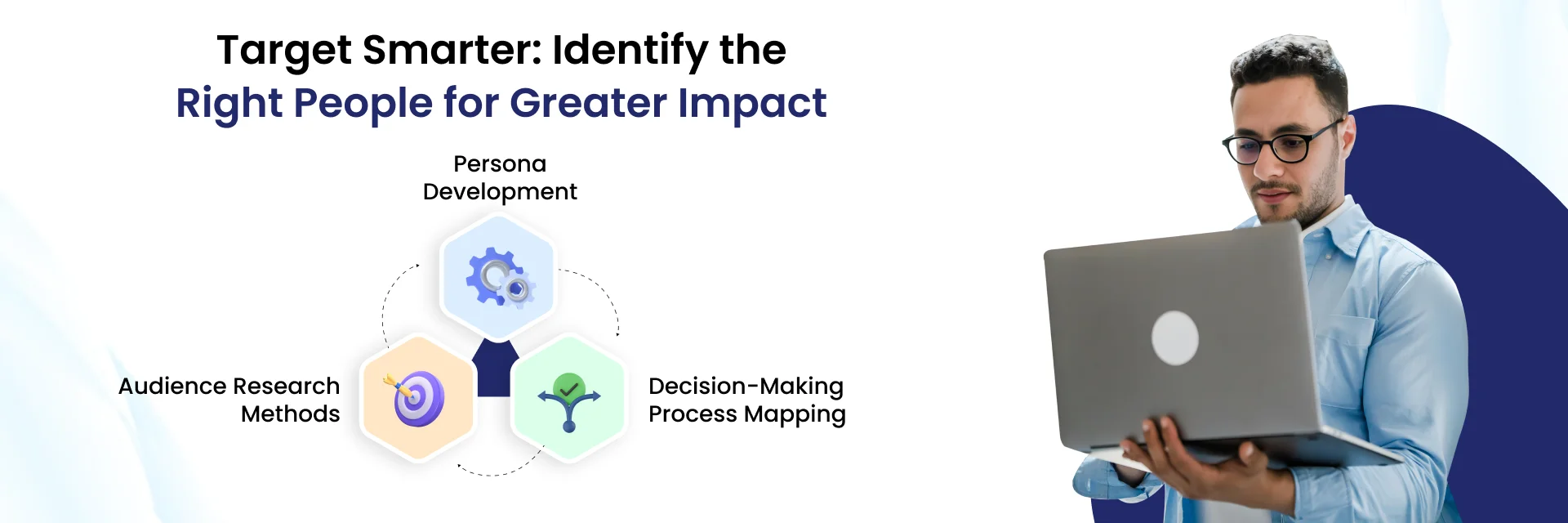
Create detailed persona profiles for each audience segment. Give them names, faces, and complete backstories. "Margaret" is your 67-year-old major donor who lost her husband last year and finds purpose in supporting causes that help other widows. "David" is your 34-year-old volunteer coordinator who works in tech and wants to use his project management skills for social good.
Interview real supporters to understand their motivations. What initially drew them to your cause? What keeps them engaged month after month? What would make them stop supporting you entirely?
Use surveys, focus groups, and one-on-one conversations to gather these insights.
Map out their decision-making processes, too. Major donors might research your organization for weeks before contributing. Volunteers often decide based on a single emotional moment or personal connection.
Understanding these nuances helps you time your outreach perfectly and craft messages that resonate with each group's specific concerns and aspirations.
Vague goals produce vague results every single time. Your marketing objectives must connect directly to your organization's survival and growth needs.

Instead of "increase awareness," aim to "attract 150 new email subscribers who live within 20 miles of our facility by December 31st." Rather than "get more volunteers," target "recruit 25 tutors with teaching or education backgrounds for our literacy program before the school year starts."
Each goal should advance your mission in measurable ways. If you need $50,000 to fund your youth programs, break that down into specific marketing targets. Maybe that means converting 100 new monthly donors at $50 each, or securing five corporate sponsors at $10,000 annually.
Your nonprofit marketing strategy becomes much more focused when every campaign serves a specific, quantifiable purpose.
Track both leading and lagging indicators. Email open rates and website visits are leading indicators that predict future donations and volunteer applications.
Set up systems to monitor these metrics consistently throughout your campaigns.
Your mission statement probably sounds like every other nonprofit's mission statement. Your marketing messages need to cut through that generic noise and make people stop scrolling.

Effective messaging starts with understanding the specific problems your audience faces every day. Your donors aren't just "people who care about education." They're parents are frustrated by their children's school system, teachers are overwhelmed by classroom sizes, and grandparents are worried about their grandchildren's future opportunities.
Craft stories that show your work solving these exact problems. Instead of talking about "providing educational resources," share how Maria finally helped her daughter with homework after attending your parent literacy classes.
Your messaging framework should include your unique value proposition, proof points that build credibility, and clear calls to action.
Test different messages with small audience segments before rolling them out broadly. The language that moves you might not resonate with your supporters at all.
Create A/B tests for subject lines, social media captions, and fundraising appeals.
You can't be everywhere, so choose platforms where your audience actually engages with causes like yours. This decision should be based on research, not assumptions about where nonprofits "should" market.

Your channel strategy for a nonprofit organization needs to balance reach, engagement, and resource requirements. Email marketing might reach fewer people than social media, but it typically generates higher donation rates for most nonprofits.
Research where your specific audience segments are most active and receptive.
Consider your content creation capabilities, too. Video marketing on YouTube requires different skills and time commitments than writing blog posts or designing Instagram graphics.
Don't spread yourself too thin across multiple platforms.
Plan for integration between your chosen channels. Your email campaigns should drive traffic to your website. Your social media posts should encourage email sign-ups. Your events should generate content for multiple marketing channels.
Random content creation leads to random results. Your content calendar should align with your audience's interests, seasonal giving patterns, and organizational priorities.
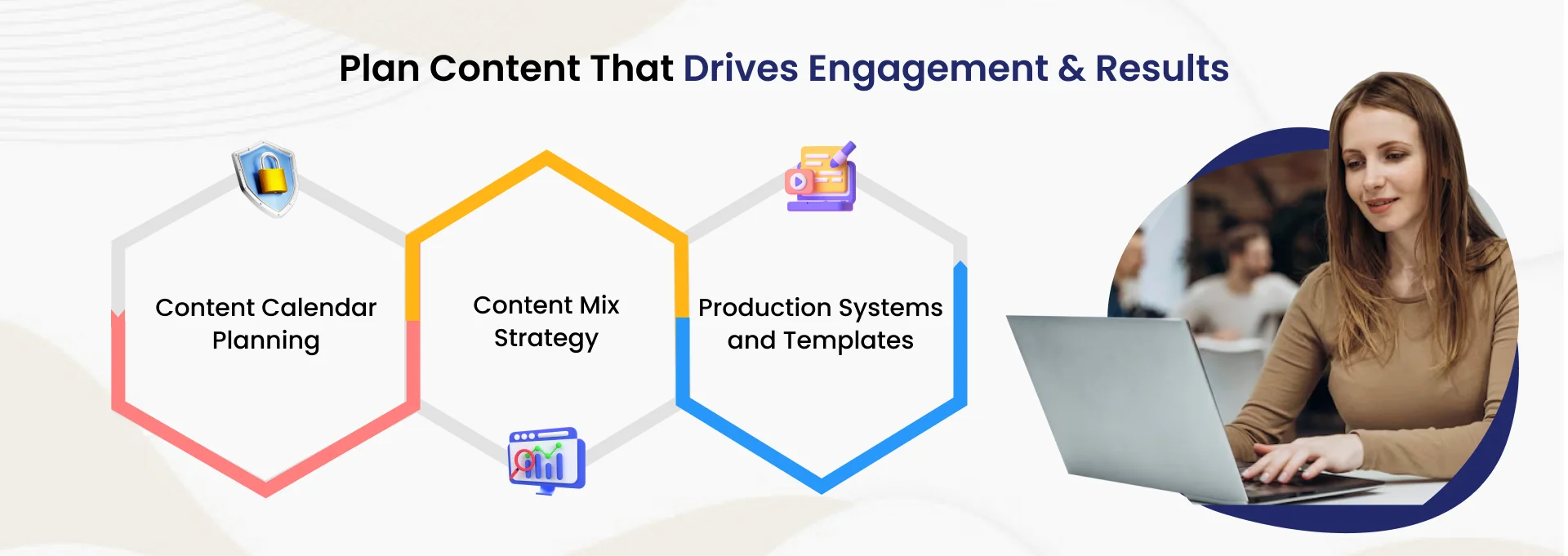
Plan content themes around your programs, impact stories, and community events. If you run a food bank, summer content might focus on childhood hunger when school meal programs pause. Environmental nonprofits can leverage Earth Day momentum, but shouldn't ignore other awareness opportunities throughout the year.
Your content mix should include education, inspiration, and direct tasks in careful balance. Too much fundraising content burns out your audience. Too few limits your revenue potential.
Follow the 80/20 rule - 80% value-driven content, 20% direct fundraising asks.
Create templates and systems that make content production faster and more consistent. Develop story gathering processes that capture compelling beneficiary stories throughout the year, not just when you need them for campaigns.
User-generated content multiplies your reach without multiplying your workload.
Even brilliant strategies fail without proper execution systems. Your implementation structure determines whether your marketing plans actually happen or sit forgotten in shared drives.

Assign specific responsibilities to team members based on their skills and availability. Your executive director shouldn't be writing every social media post, but they might need to approve major donor communications.
Create clear job descriptions for each marketing role, including volunteers.
Create workflows that prevent bottlenecks and missed deadlines. If your board requires approval for all communications, build that review time into your content calendar.
Document every process so new team members can jump in quickly.
Volunteer coordination requires special attention in a nonprofit organization's marketing strategy. Volunteers bring enthusiasm but may lack marketing experience. Provide clear guidelines, templates, and regular check-ins to keep efforts aligned.
Establish regular team meetings focused solely on marketing progress.
Tracking the right metrics separates successful nonprofits from those that struggle year after year. Your measurement system should connect marketing activities to mission outcomes, not just vanity metrics like follower counts.

Focus on donor lifetime value, volunteer retention rates, and program enrollment numbers that directly impact your organization's effectiveness. A campaign that generates 1,000 new followers might matter less than one that recruits 10 committed monthly donors.
Choose 3-5 primary metrics that directly connect to your mission goals.
Set up regular review cycles that allow for course corrections before campaigns end. Monthly data reviews help you identify what's working early enough to double down on successful tactics.
Create dashboard reports that make data easy to understand for all team members.
Document what you learn for future campaign planning. Your successful email subject lines, social media post formats, and volunteer recruitment messages become templates for future efforts.
Build a knowledge base that captures institutional learning over time.
This systematic approach transforms scattered marketing efforts into a powerful engine for mission advancement. Each step builds on the previous one, creating momentum that compounds over time.
Your strategy framework is solid, but now you need specific tactics that work in the digital marketing world. These aren't trendy marketing gimmicks - they're the core methods that top-performing nonprofits use to build lasting relationships online.
The best part? You don't need a massive budget to implement these proven nonprofit marketing tactics effectively.
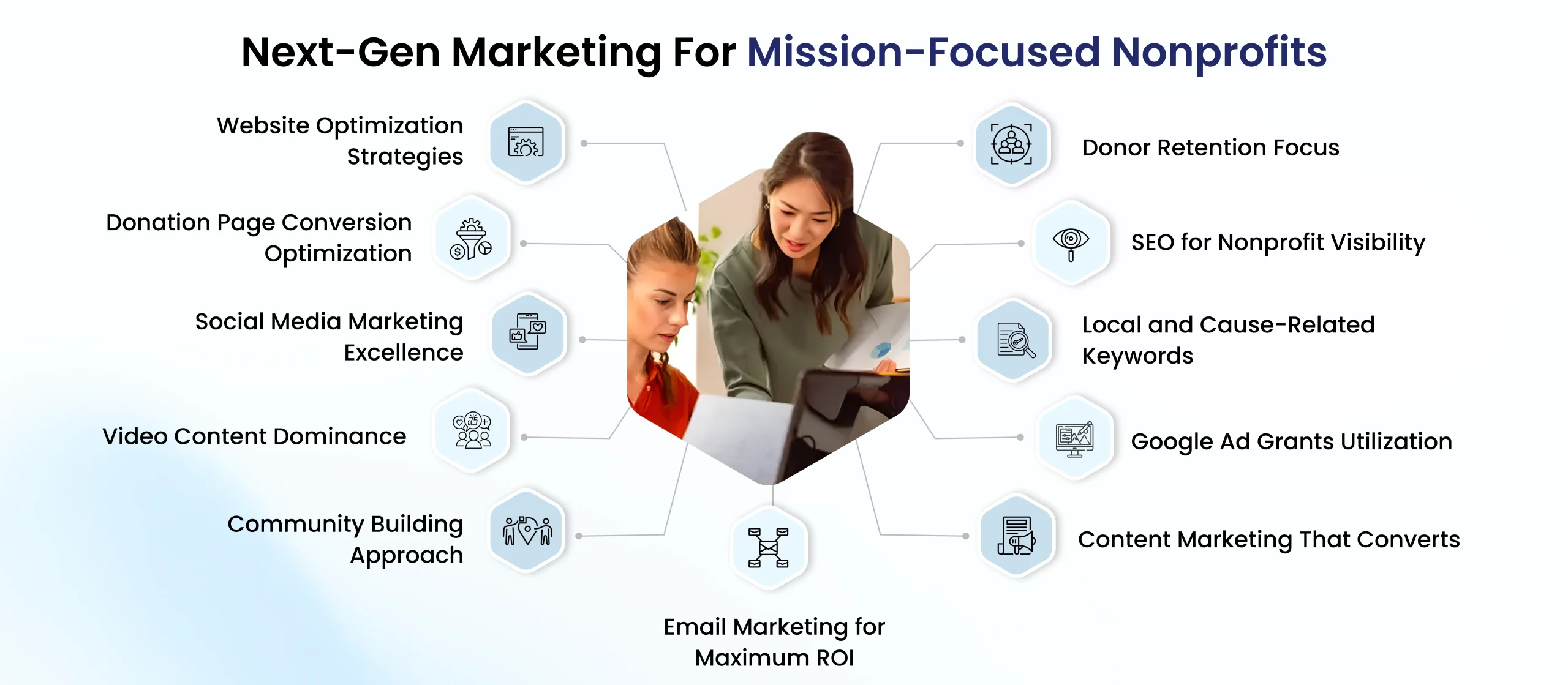
Where curiosity turns into connection and interest turns into action. Every campaign should lead people here, whether they’re ready to donate, volunteer, or learn more. Ensure your site is mobile-responsive, easy to navigate, and built for speed. A clean design with clear calls-to-action can dramatically boost engagement and conversions..
Your donation page might be costing you thousands in lost contributions. Simple changes can dramatically improve conversion rates without spending extra money on traffic.
Remove unnecessary form fields that create friction. Ask for name, email, and donation amount - that's it. You can gather additional information after someone becomes a committed supporter.
Make your site mobile-friendly since over 60% of nonprofit website visitors use mobile devices. If your donation process doesn't work perfectly on phones, you're turning away more than half your potential supporters.
Social media is more than a branding tool. it’s your frontline for storytelling, community-building, and donor acquisition. Create posts that start conversations, not just broadcasts. Highlight real people, show behind-the-scenes moments, and respond to comments. When used intentionally, platforms like Instagram and TikTok can turn passive scrollers into passionate supporters. About 41% of Gen Z say social media has motivated them to research or donate to a cause.
Short-form video content consistently performs better and is incredibly popular on TikTok and Instagram. You don't need expensive equipment - smartphone videos often feel more authentic and relatable. Focus on people and stories rather than programs and statistics. Show the volunteer who found purpose after retirement or the family whose life changed through your services.
Don’t just aim for followers, build a real community that believes in your cause and supports it together. Share user-generated content, repost volunteer photos, and ask for opinions or stories. When people feel like they’re part of something bigger, they’re more likely to stay engaged, donate regularly, and bring others along with them.
While social algorithms fluctuate, your email list is something you fully control, and it delivers the highest ROI of any digital channel. Use it to nurture your audience with personalized updates, thank-yous, and impact stories. A strong email strategy builds long-term trust and brings in consistent donations without the noise of social media competition.
Your current donors are 70% more likely to give again than new prospects are to give for the first time. Send impact updates that show exactly how previous donations made a difference.
Create automated sequences for new donors that build relationships and explain impact. These systems work 24/7 to nurture relationships while your team focuses on strategy.
When people search for help or causes to support, your nonprofit organization should be one of the first things they see on Google search results. That’s where search engine optimization (SEO) comes in. By using the right nonprofit SEO keywords, creating optimized blog content, and improving your website’s SEO structure, you increase online visibility and drive organic traffic. This helps attract supporters, volunteers, and donors who are already actively searching for charities to support, nonprofit services, or ways to make a difference online.
Most nonprofits serve specific geographic areas, making local SEO crucial. Include location-specific keywords naturally in your content. "Food bank in downtown Seattle" performs better than a generic "food assistance program".
Create content that answers common questions about your cause area. "How to help homeless veterans" can attract people ready to take action.
Google offers eligible nonprofits $10,000/month in free ad credits, but most don’t use them to their full potential. Rather than promoting your homepage, build focused ad campaigns for programs, donation drives, or volunteer signups. With a little strategic effort, this grant can bring in thousands of high-intent visitors every month, without touching your main budget.
Strategic content creation establishes your organization as a trusted authority while attracting people who care deeply about your cause. About 92% of nonprofit marketers use content marketing because it works.
Write educational content about issues related to your mission. This attracts supporters who want to learn and help, building long-term relationships that sustain your organization.
Document and share the measurable changes your organization creates. Numbers matter, but combine them with human stories for maximum impact.
Here's the truth that might surprise you: some of the most effective nonprofit campaigns come from organizations with the smallest marketing budgets. They've cracked the code on stretching every dollar while their well-funded competitors struggle with expensive strategies that don't deliver.
The secret isn't magic - it's knowing exactly where to find the tools and people that multiply your impact without emptying your bank account.
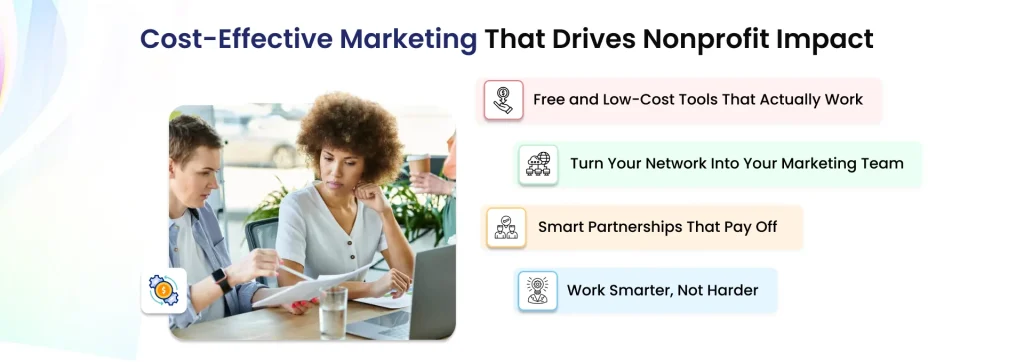
Stop paying for expensive design software when Canva offers professional nonprofit templates for free. Your social media graphics can look just as polished as those created by agencies charging thousands.
Mailchimp handles your email marketing needs without cost for up to 2,000 subscribers. That's probably your entire supporter list right now, which means professional email campaigns cost you absolutely nothing.
Google Analytics reveals exactly which content moves people to donate or volunteer. No more guessing what works - the data shows you the path to success.
Your board members are sitting on goldmines of connections and expertise; they're probably eager to share. That quiet board member might have 3,000 LinkedIn connections or decades of marketing experience.
Your volunteers bring fresh perspectives and energy that paid staff sometimes lack. College students understand platforms your team has never heard of, while retirees often have the time and skills to contribute significantly.
Local coffee shops, restaurants, and retail stores often share nonprofit content with their customers because it makes them look community-minded. These partnerships cost nothing but expand your reach tremendously.
Collaborating with similar organizations creates win-win situations. When you cross-promote each other's events and programs, everybody's audience grows.
Automation handles the repetitive stuff while you focus on building relationships. Birthday emails, welcome messages, and thank you notes can run automatically while maintaining that personal touch supporters crave.
One piece of content should work across multiple channels. Transform your success stories into blog posts, social media content, newsletter features, and volunteer training examples.
Every nonprofit faces similar marketing hurdles: tight budgets, small teams, mixed audiences, and hesitant boards. But these aren’t roadblocks; they’re solvable challenges with clear, proven solutions. Organizations just like yours have already navigated these issues and come out stronger. You don’t need to start from scratch or repeat the same mistakes. With the right approach, even the leanest nonprofit can market smarter, grow faster, and make a bigger impact.

Your marketing budget feels impossibly small compared to what you think you need. Here's what successful organizations do instead of complaining about money they don't have.
They focus on one marketing channel at a time until it works consistently. Master Facebook before trying Instagram. Perfect your email campaigns before launching a blog.
Partner with local businesses for cross-promotional opportunities that cost nothing but time. The coffee shop down the street might display your event flyers if you promote their business to your supporters.
Apply for Google Ad Grants that provide up to $10,000 monthly in free advertising. Most nonprofits never even know this program exists, giving you a massive advantage over your competition.
You're wearing seventeen different hats, and marketing feels like job number eighteen on your endless to-do list. The solution isn't working longer hours - it's working smarter with systems.
Batch similar tasks together instead of switching between different activities all day. Write all your social media posts for the week in one sitting. Schedule them using free tools so posting happens automatically.
Create templates for everything you do repeatedly. Volunteer welcome emails, donor thank you messages, and event announcements should follow proven formats that save hours of writing time.
Your donors want different information from your volunteers, who need different messages than your program beneficiaries. Trying to speak to everyone simultaneously usually means connecting with no one effectively.
Segment your email lists by audience type and send targeted messages that address each group's specific interests and motivations.
Use different social media platforms for different audiences instead of posting identical content everywhere.
Your board questions every marketing expense while expecting miraculous fundraising results. Show them exactly how marketing activities connect to donation increases and volunteer recruitment numbers.
Present monthly reports that link marketing metrics to mission outcomes. When board members see clear cause-and-effect relationships, they become marketing champions instead of skeptics.
These common challenges have straightforward solutions once you know what actually works in the real world.
You've launched your marketing efforts, and supporters are responding. But here's the critical question: are you tracking the right numbers or just celebrating meaningless vanity metrics?
Most nonprofits get this completely wrong. They celebrate Facebook likes while missing donors who quietly disappear. They count email opens but ignore volunteer retention rates that actually predict organizational health.

Forget impressive-looking numbers that don't pay your bills. Focus on metrics that directly connect to your mission's survival:
A campaign bringing 50 new donors at $25 each beats one attracting 5 donors at $250 if those smaller donors stick around longer.
Your nonprofit marketing plan should generate data that improves future decisions, not just document past activities.
Track which channels produce the most engaged supporters over time. Volunteers recruited through community events often stay longer than those found through online ads.
Monitor how different messaging affects donor behavior. Does storytelling about individual beneficiaries generate larger gifts than program statistics?
Document seasonal engagement patterns to time major campaigns for maximum impact.
Treat marketing like science experiments. Test approaches, measure carefully, and double down on what works while eliminating what doesn't.
Set up monthly data review meetings focused solely on performance analysis. Create simple tracking systems using spreadsheets rather than complicated software nobody understands.
When you clearly see which nonprofit marketing tactics produce results, scaling successful efforts becomes straightforward.
This data-driven approach transforms marketing from expensive guesswork into a reliable engine for sustainable growth.
You now have the complete roadmap to transform scattered marketing efforts into a mission-advancing powerhouse. The nonprofits implementing these strategies see 40% higher donor retention and consistently attract more dedicated volunteers.
Your next step is simple: pick one strategy from this guide and implement it this week. Start small, measure results, and build momentum.
You don't have to do this alone. Many successful nonprofits accelerate their progress by partnering with experienced digital marketing professionals who understand the unique challenges of mission-driven organizations.
At JanBask Digital Design, our expertise in digital marketing for nonprofits helps organizations implement proven strategies that deliver real results. If you'd like to explore how a strategic partnership can amplify your impact, let’s discuss your mission and goals.
Your cause deserves to reach everyone who cares about making a difference.
Discover the Complete 8-Step Nonprofit Strategy

M
“Great blog! Nonprofits often face challenges with limited resources, and these marketing strategies provide a clear path to increasing visibility and impact. Thanks for sharing!”
O
“Awesome blog post! Marketing for nonprofits can be tricky, but these tips make it seem much more achievable. I’ll definitely be recommending this to my network!”